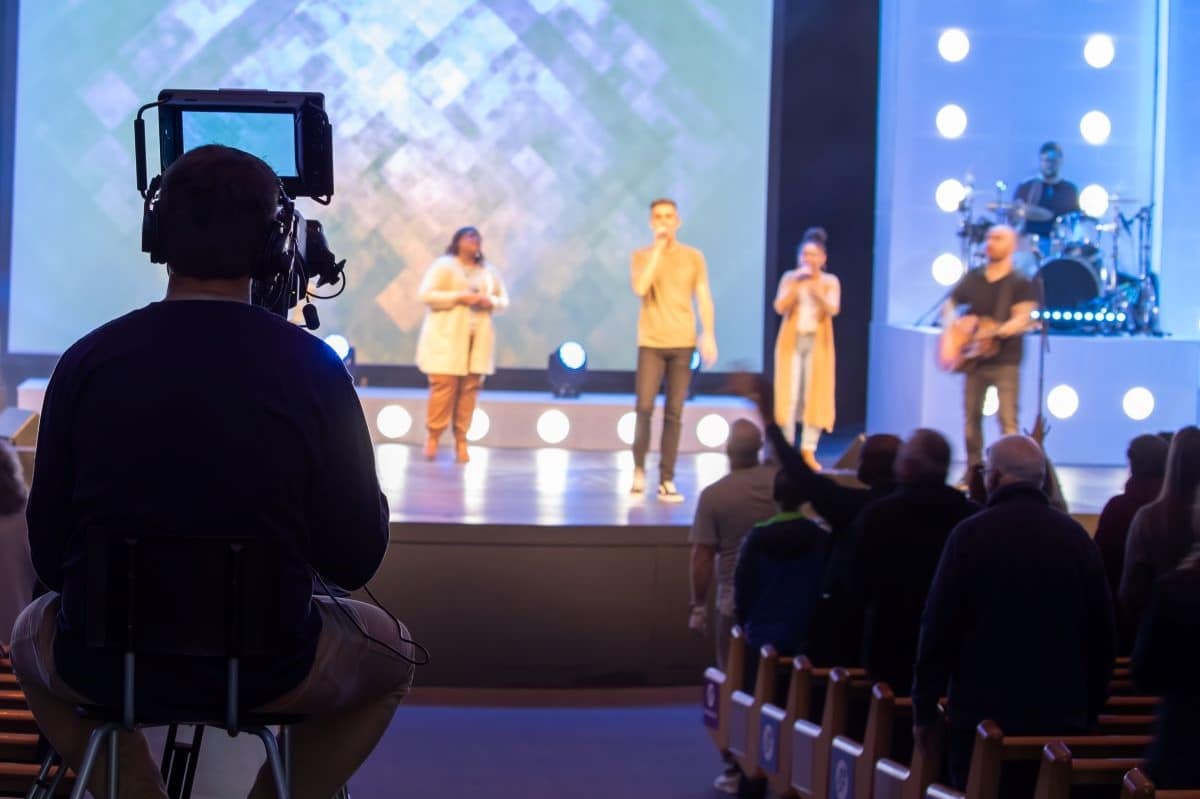While there was a time when hybrid worship appeared temporary, 81% of churches now say they will continue offering services in a hybrid format for the foreseeable future. Expanding both in-person and remote attendance levels can be challenging. Growing both audiences centers on creating an engaging worship service and building a sense of community among the congregation. However, churches will need to adopt different strategies to target each audience.
That’s where a connected ecosystem of AV tech can help. While certain technologies will support in-person engagement, others will drive up remote attendance. Let’s explore how these specific AV solutions will help achieve these goals in each worship environment.
Engage In-Person Attendees with an Immersive Visual Worship Experience
Younger generations seek out immersive, tech-based experiences in all aspects of their lives from entertainment to shopping. In fact, a survey of Gen Z consumers found that 59% prefer to shop in stores that offer an immersive experience, such as those powered by AR and VR.
While deploying AR and VR tech may seem overwhelming, projection technology offers a simpler way for churches to create their own interactive visual worship experience. Projecting the readings on the wall, alongside images to highlight key messages, helps everyone follow along regardless of whether they have a physical copy of the reading in front of them. These images can help evoke emotion and inspiration and spark enthusiasm among the audience, fostering a shared experience throughout the congregation. Likewise, digital displays can help support these immersive visuals by providing an easy way for church leaders to share the page numbers for the readings and songs.
Digital displays can also help create a cohesive worship experience on busy holidays when it’s difficult to fit all congregants in one room. Holding two separate simultaneous services strains resources and prevents everyone from experiencing the same holiday service. With high-quality cameras and live production tech, houses of worship can stream a service happening in one room to multiple digital displays in different rooms across the church campus, creating a better sense of community through shared experience. This also sets the church up well to livestream services to worshippers at home.
Engage Remote Worshippers with a High-Quality Broadcast
Worshippers tuning in from home have a lot of options to choose from when selecting a streamed service. In fact, the majority of people who tune into services remotely do so in order to watch a service held far away from where they live. This means your house of worship may have an audience of remote worshippers outside of your physical town or city. That’s where the quality of the livestream makes the difference between worshippers engaging with your broadcast or switching to a service offered by another church.
A high-quality livestream starts with deploying audio technology best suited to your space. If viewers can’t hear the speaker or the music, they’re likely to switch to a different livestream. A wireless microphone system that delivers secure, reliable sound in both large and small spaces is critical, allowing churches to capture high quality audio whether they are in the main chapel or in a smaller secondary chapel. And having a microphone and receiver that are pair-registered means there will be no interference from other wireless devices, minimizing issues for volunteer production teams.
Having the right cameras also plays a critical role in creating a high-quality broadcast. PTZ cameras are an ideal option for churches looking to stream their in-person services to a remote audience because they come in compact sizes and blend in well with the church’s existing beams, pillars, and overall environment. This way, they avoid interfering with the architectural beauty of the space. They are also easy to operate, as they manually track the speaker to stay focused on the subject. And when music is playing, they can pan the room to highlight different details from the musicians to the stained-glass windows, making remote worshippers feel as if they are there in person.
PTZ cameras also pair well with studio cameras for a multi-camera broadcast. For instance, a church may want to stream a children’s pageant where there’s a narrator telling the story as multiple actors perform it. The church production team can use a studio camera to capture consistent footage of the narrator while the PTZ cameras capture the movements of the actors. With a comprehensive, easy-to-use live production platform, the production team can seamlessly compile footage from each camera and stream it.
Promote In-Person Gatherings with More Visual Tech
Church membership fell below 50% for the first time in 2020. To prevent that number from dropping further, houses of worship are focusing on engaging worshippers through community gatherings, like church picnics and clothing drives.
Effectively gathering the community means everyone needs to know when and where these events are happening. That’s where digital signage can help. Worship leaders can use digital signage displays to share multiple updates with congregants at once. This digital platform catches people’s attention better than a sea of paper signs pinned to a bulletin board, each advertising different events.
Integrate Remote Worshippers into the Community with High-Quality Camera & Audio Tech
Only 28% of remote worshippers feel connected to the worshippers physically attending the services they watch and even fewer feel connected to other people tuning in remotely. But, when deployed appropriately, AV technology can help houses of worship build a community that brings their remote and in-person worshippers together. For instance, by spanning the room to show all in-person congregants in attendance, PTZ cameras help remote worshippers feel as if they are in the room with other worshippers.
Similarly, PTZ cameras paired with a wireless microphone system can help churches convert small group meetings, like Bible study sessions, to a hybrid format. While the PTZ cameras help track the speaker, high-quality audio tech ensures everyone’s voice is heard regardless of whether they are present in person or tuning in remotely, fostering a strong sense of community among all congregants.
Looking Ahead
Technology will play a crucial role in future hybrid worship. With each solution deployed appropriately, a connected ecosystem of AV tech will help worship leaders create engaging services and build community for both remote and in-person attendees.
Steve Milley serves as director of sales, professional imaging and visual systems at Panasonic Connect, na.panasonic.com. He has spent the majority of his career focused on the development of video, audio, and visual technologies.












